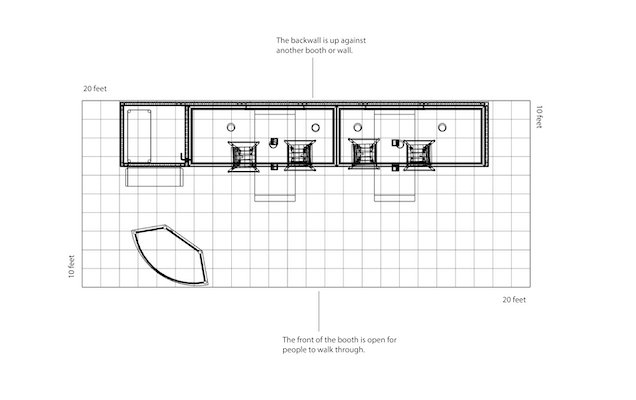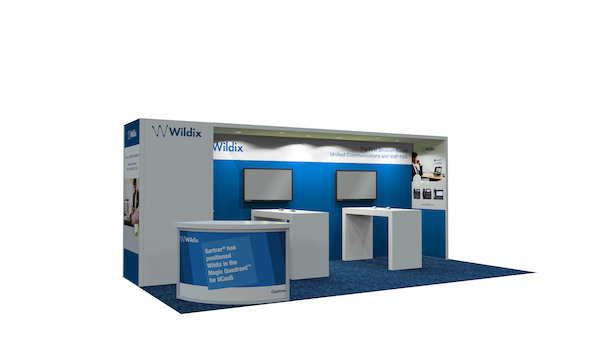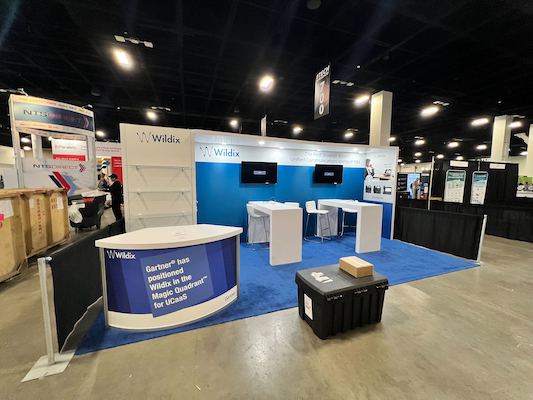If you’re just getting started in the trade show circuit, you may ask yourself: What is an inline booth? How does it differ from other types of booths, and when should you use one?
Even if you’re a seasoned exhibitor, you always need to think about the best ways to maximize your space and your budget, work around the regulations at different trade shows, and figure out how to accomplish everything you need in the space that you purchase.
With decades of trade show experience, our experts are here to share the answers to these questions and more.
Table of Contents
- What Is an Inline Booth, Exactly?
- The Pros and Cons of Inline Booths
- What Are the Pros of Inline Booths?
- More Manageable and Affordable
- Testing New Ideas
- Reusable for Multiple Events
- Using Multiple Booths at Big Events
- What Are the Cons of Inline Booths?
- How to Make the Most of an Inline Booth
- Make Smart Adjustments and Reuse Your Inline Booth
- Choose Your Location Strategically
- Avoid Overcrowding Your Booth
- Change Up Your Lighting
- Design and Build Your Ideal Inline Booth with Cardinal Expo
What Is an Inline Booth, Exactly?

To start, what is an inline booth? An inline booth is usually a 10’x10’ booth or 10’x20’ booth that sits along an aisle between other exhibitors. Occasionally, an inline booth can get up to 10×30 feet, depending on the expo limitations. The height is usually limited to 8 feet.
An inline booth is sometimes called a “linear booth,” as it sits inside a line of other booths. It is the most commonly seen type of trade show booth when attending large expos, as many of them can fit in close spaces and tight quarters.
Typically, an inline booth only has the front side open to the aisle. This booth type often sits back-to-back with other inline booths. Inline booths can also sit with their backs to the expo hall perimeter, an exterior wall, or some other large architectural feature that cuts up the event space. In this case, they are sometimes also referred to as a “perimeter booth.”
The Pros and Cons of Inline Booths
When choosing the right size booth and the right type of booth for a trade show, there is no right answer or one-size-fits-all option. Every booth has its pros and cons. Learn about the pros and cons of inline booths to help you make an informed decision.
What Are the Pros of Inline Booths?
More Manageable and Affordable
Inline booths are easily the most manageable booths. They’re great if you are planning on having just one or two people to work your booth at the trade show or expo, as a large team could easily overwhelm this space. Inline booths are also inexpensive and fall under almost every kind of budget.
Need to stretch your budget even further? Be sure to check out our tips for great trade show booth design on a budget as well.
Testing New Ideas
This booth type is also a strong choice for those that are not sure if a trade show will be good for business. An inline booth allows you to test out a trade show without committing to the cost of something larger.
After you’ve exhibited once and learned what worked and what didn’t, you can determine if it’s worth exhibiting again or even making a greater investment into that show in the future. You can also use an inline booth to test audience reactions to a new product or service without investing in a huge booth.
Reusable for Multiple Events
If you want to attend a higher number of events, inline booths are easy to reuse from show to show since they are so prevalent. Save money and hassle by simply designing an inline booth that can be adapted to each event with smaller modifications. You may even be able to ship directly from one show to the next, reducing your shipping and storage costs.
Using Multiple Booths at Big Events
At larger events, instead of buying one big space for a single booth, you could buy two or three inline booths for around the same price. For example, you might get four 10×20 booths instead of one 40×40 booth for the SEMA Car Show or National Hardware Show. This way, you can increase your visibility at the show with booths in several key areas.
A show attendee may not make it to every corner of the exhibit hall at a huge show. With multiple booths, you stand a better chance of making an impression. And if any showgoers happen to see more than one of your booths, you have the benefit of creating multiple touchpoints with them.
What Are the Cons of Inline Booths?
Smaller Size
Because of their size, inline booths will not work with every company. Don’t try to cram too much into a smaller booth, or you’ll risk putting off visitors by looking disorganized or overcrowded.
Make a list of everything you need to include in your booth, such as:
- Product displays or shelves
- Space to perform demonstrations
- Space for booth games or entertainment
- Storage space
- Meeting space
Ask yourself what size booth you’ll need to accommodate for everything, plus your staff and your visitors. If you want a lot of space for different products and engagements, then an inline booth may be too restricting for your needs.
More Show Restrictions
Inline booths face a number of show restrictions, which don’t always apply to every kind of trade show booth. For instance, you can usually only build inlines to an 8-foot height limit. You also can’t hang anything from the ceiling in an inline booth.
In most cases, you can’t block the sides of your inline booth with large items. You’re required to keep the aisle open. With an inline booth, visitors won’t be able to enter or exit from all sides of your booth, and you won’t be able to entertain attendees from all sides either.
Less Desirable Locations
Depending on where you’re located, an inline booth may not be visible from across the convention hall, while more island booths have that additional visibility. The spots right by the entryways are usually islands, while inline booths are typically located around a central hub. Main aisles are often taken up by larger companies with larger exhibit spaces as well.
More Competition for Attention
Because inline booths are nestled between two other booths, there is a lot more competition for attention as people roam the expo compared to a well-placed island booth or large double deck booth. This may not be an issue if you know you have particularly dynamic salespeople or especially unique products or services.
However, if you are worried about getting lost in the crowd, then you may want to choose another booth type. But before you give up on inline booths, keep reading for our expert tips on how to make the most of an inline booth below!
How to Make the Most of An Inline Booth
Just because an inline booth has a small space does not mean that they have to fall in with the crowd. If you are like the 88% of exhibitors whose goal is to increase brand awareness by exhibiting at a trade show, then what is more important than space is to plan strategically and stand out.
Make Smart Adjustments and Reuse Your Inline Booth
As mentioned in our pros of inline booths, a great way to maximize the use of your booth is by reusing it at different events. This will reduce your costs for design and fabrications, as well as shipping and storing your booth if you are able to ship it directly from one show to the next.
But you don’t want to make your booth completely generic just so it can be reused. Instead, plan for major design elements that can remain the same across shows, as well as smaller graphics and changes that can be made easily between shows. This way, your booth is still customized to each event and audience.
Choose Your Location Strategically
With an inline booth, we recommend looking for a corner space at the end of the aisle so you’ll have one side open. This is a creative way to open up your square footage and give you a little more space away from your neighboring exhibitors—at least on one side.
By choosing one of these strategic placements, you can actually work the aisle. Think of it this way: if you have a 10×20 booth with an open side, then you actually have 30 feet of open space to work out of, instead of 20 feet that’s stuck between two neighbors.
If you have a bigger budget, you can even get multiple inline booths for the price of a single larger booth. By exhibiting with several inline booths at bigger events, you can cover more ground and increase your visibility.
Avoid Overcrowding Your Booth
As mentioned in our cons of inline booths, this type of booth runs the risk of quickly becoming overcrowded and putting off visitors. Resist the temptation to fit more into your space than you can truly accommodate, and you’ll actually perform better at the expo.
Make sure visitors can step out of the aisle and into your booth comfortably. Both staff and visitors should be able to move through your booth with ease. Keep your booth tidy and neat, and follow the rules of trade show etiquette.
Change Up Your Lighting
Another way to make your inline booth stand out is to use unique lighting. With a combination of effective colors and lighting in an inline booth, you can transform a small space into another world when people walk in.
If you’re interested in trying out new lighting combinations, you could try using small spotlights to showcase particularly important products. Businesses with unique logos could also try accent lighting to add dimension to their graphics.
Small neon lights—especially custom work that looks like your business logo or represents important parts of the company—can also add an element of fun and an extra texture to your inline booth.
Design and Build Your Ideal Inline Booth with Cardinal Expo

At Cardinal Expo, we are always eager to help our customers make the most of their trade show experiences. We have created custom trade show exhibits for the past 28 years. We are constantly innovating and participating in major events across the U.S. with clients of all sizes. Not only do we design trade show booths, but we also build, ship, install, dismantle, and store them.
Contact us below to get a free quote and talk about how we can help with your next trade show booth.
Contact Us Today
We at Cardinal Expo are here to answer any questions you may have, provide you with additional information, and create an effective solution for your exhibit needs.
"*" indicates required fields

